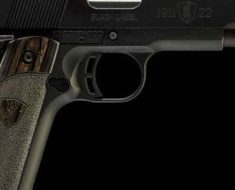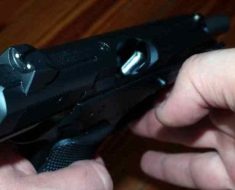“Empower yourself responsibly with semi-auto pistols for self-defense.”
The Importance of Proper Training and Education
When it comes to self-defense, many individuals turn to semi-automatic pistols as their weapon of choice. These firearms are popular due to their ease of use, reliability, and firepower. However, it is crucial for individuals to understand the ethical implications of using semi-auto pistols in self-defense situations. Proper training and education are essential to ensure that individuals can use these firearms responsibly and ethically.
One of the most important aspects of using a semi-auto pistol in a self-defense situation is understanding how to handle the firearm safely. This includes knowing how to properly load and unload the weapon, as well as how to aim and fire accurately. Without proper training, individuals may inadvertently put themselves or others at risk when using a semi-auto pistol in a high-stress situation.
Training also helps individuals understand the legal implications of using a firearm in self-defense. It is crucial for individuals to know when it is appropriate to use deadly force and when it is not. Without this knowledge, individuals may find themselves facing legal consequences for their actions, even if they were acting in self-defense.
Additionally, proper training and education can help individuals develop the skills needed to de-escalate a potentially dangerous situation without resorting to violence. In many cases, simply displaying a firearm can be enough to deter an attacker. However, individuals must be prepared to use their firearm if necessary, and training can help them make that decision in a split-second.
Furthermore, training can help individuals understand the ethical implications of using deadly force. While it is important to protect oneself and others from harm, it is also important to consider the consequences of taking a life. Proper training can help individuals make informed decisions about when to use deadly force and when to seek alternative solutions.
In addition to training, education is also essential for individuals who choose to use semi-auto pistols for self-defense. Understanding the mechanics of the firearm, as well as how to properly maintain and care for it, is crucial for ensuring that the weapon functions properly when needed. Without this knowledge, individuals may find themselves in a dangerous situation with a malfunctioning firearm.
Education also helps individuals understand the limitations of semi-auto pistols in self-defense situations. While these firearms are powerful and reliable, they are not foolproof. Individuals must be aware of the potential for malfunctions or misfires and know how to respond in such situations.
Overall, the ethical use of semi-auto pistols in self-defense situations requires proper training and education. Individuals must be prepared to handle their firearms safely, legally, and ethically. By investing time and effort into training and education, individuals can ensure that they are prepared to protect themselves and others responsibly in a dangerous situation.

Understanding Legal Implications and Responsibilities
When it comes to self-defense, many individuals turn to semi-automatic pistols as their weapon of choice. These firearms are popular due to their ease of use, reliability, and firepower. However, it is crucial for gun owners to understand the ethical implications and legal responsibilities that come with using a semi-auto pistol in a self-defense situation.
First and foremost, it is important to remember that owning a firearm is a serious responsibility. As a gun owner, you have a duty to handle your weapon safely and responsibly at all times. This includes keeping your firearm securely stored when not in use, practicing proper gun safety techniques, and being aware of your surroundings when carrying a weapon.
When it comes to using a semi-auto pistol in a self-defense situation, there are several ethical considerations to keep in mind. One of the most important factors to consider is the concept of proportionality. This means that the level of force used in self-defense must be proportional to the threat faced. In other words, you should only use deadly force if you believe that your life or the lives of others are in immediate danger.
Another ethical consideration is the concept of duty to retreat. In some states, individuals have a legal obligation to retreat from a dangerous situation if it is safe to do so before using deadly force. This means that you should only use your semi-auto pistol as a last resort when all other options have been exhausted.
In addition to ethical considerations, there are also legal implications to using a semi-auto pistol in self-defense. It is important to familiarize yourself with the laws in your state regarding the use of deadly force. This includes understanding when you are legally justified in using your firearm to defend yourself or others.
In many states, individuals have the right to use deadly force in self-defense if they believe that they are in imminent danger of death or serious bodily harm. However, it is crucial to remember that the burden of proof is on you to demonstrate that your use of force was justified. This means that you may be required to provide evidence that you were in fear for your life or the lives of others at the time of the incident.
It is also important to remember that using a semi-auto pistol in self-defense can have serious legal consequences. Even if you are justified in using deadly force, you may still face criminal charges and civil lawsuits. It is crucial to consult with a qualified attorney who specializes in self-defense cases to ensure that you understand your rights and responsibilities under the law.
In conclusion, the ethical use of semi-auto pistols in self-defense situations requires careful consideration of both moral and legal implications. Gun owners must be aware of their responsibilities when carrying a firearm and be prepared to act with restraint and caution in dangerous situations. By understanding the ethical and legal considerations of using a semi-auto pistol in self-defense, individuals can better protect themselves and others while upholding their rights and responsibilities as gun owners.
Ethical Considerations of Using Deadly Force
When it comes to self-defense, there are many factors to consider, including the ethical use of semi-automatic pistols. While these firearms can be effective tools for protecting oneself in dangerous situations, it is important to approach their use with caution and a strong sense of ethics.
One of the key ethical considerations when using a semi-automatic pistol in self-defense is the concept of proportionality. This means that the level of force used must be proportional to the threat faced. In other words, it is not ethical to use deadly force against a non-lethal threat. For example, shooting someone who is unarmed and posing no immediate danger would not be considered ethical.
Another important ethical consideration is the concept of necessity. This means that the use of deadly force must be necessary to protect oneself or others from harm. In a self-defense situation, this may mean that using a semi-automatic pistol is the only way to stop an attacker who is armed and intent on causing harm. However, it is important to carefully assess the situation and consider all other options before resorting to deadly force.
In addition to proportionality and necessity, it is also important to consider the concept of reasonableness when using a semi-automatic pistol in self-defense. This means that the actions taken must be reasonable given the circumstances. For example, shooting someone who is fleeing the scene and no longer poses a threat would not be considered reasonable.
It is also important to consider the potential consequences of using a semi-automatic pistol in self-defense. While these firearms can be effective tools for stopping threats, they also have the potential to cause serious injury or death. It is important to be aware of this fact and to use these weapons responsibly.
One way to ensure the ethical use of semi-automatic pistols in self-defense is to undergo proper training and education. This includes learning how to safely handle and operate these firearms, as well as understanding the legal and ethical considerations of using deadly force. By being well-informed and prepared, individuals can make more ethical decisions in high-stress situations.
It is also important to consider the aftermath of using a semi-automatic pistol in self-defense. This may include legal repercussions, emotional trauma, and potential harm to relationships with others. It is important to be prepared for these consequences and to seek support if needed.
In conclusion, the ethical use of semi-automatic pistols in self-defense situations is a complex issue that requires careful consideration. By understanding concepts such as proportionality, necessity, reasonableness, and consequences, individuals can make more ethical decisions when faced with a threat. Proper training and education are also essential to ensure that these firearms are used responsibly. Ultimately, the goal should be to protect oneself and others while minimizing harm and upholding ethical standards.
Alternatives to Lethal Force in Self-Defense
When it comes to self-defense, there are a variety of tools and techniques that individuals can use to protect themselves in dangerous situations. One common tool that is often used for self-defense is the semi-automatic pistol. While these firearms can be effective in stopping threats, it is important for individuals to understand the ethical considerations that come with using them in self-defense situations.
One of the key ethical considerations when using a semi-automatic pistol in self-defense is the level of force that is necessary to stop the threat. In many cases, individuals may feel that using lethal force is the only way to protect themselves from harm. However, it is important to remember that lethal force should only be used as a last resort when all other options have been exhausted.
In situations where lethal force is not necessary, individuals should consider using alternative methods to defend themselves. This could include using non-lethal weapons such as pepper spray or a stun gun, or employing de-escalation techniques to defuse the situation before it escalates to violence. By using these alternative methods, individuals can protect themselves without causing unnecessary harm to others.
Another ethical consideration when using a semi-automatic pistol in self-defense is the potential for collateral damage. When firing a firearm in a crowded or public area, there is always the risk of hitting innocent bystanders or causing property damage. Individuals should be aware of their surroundings and take precautions to minimize the risk of collateral damage when using a firearm for self-defense.
In addition to considering the level of force and potential for collateral damage, individuals should also be mindful of the legal implications of using a semi-automatic pistol in self-defense. In many jurisdictions, there are strict laws governing the use of lethal force, and individuals who use a firearm in self-defense may be subject to criminal charges if they are found to have acted recklessly or negligently.
To ensure that they are using their semi-automatic pistol ethically in self-defense situations, individuals should familiarize themselves with the laws in their jurisdiction and seek training from qualified instructors on how to safely and responsibly use a firearm. By understanding the legal implications of using a firearm in self-defense, individuals can protect themselves from legal consequences while also protecting themselves from harm.
In conclusion, the ethical use of semi-automatic pistols in self-defense situations requires individuals to consider the level of force necessary, the potential for collateral damage, and the legal implications of using a firearm. By using alternative methods to defend themselves when lethal force is not necessary, individuals can protect themselves without causing unnecessary harm to others. By seeking training and understanding the laws in their jurisdiction, individuals can ensure that they are using their semi-automatic pistol responsibly and ethically in self-defense situations.
Addressing Common Misconceptions and Myths about Semi-Auto Pistols
Semi-automatic pistols are a popular choice for self-defense due to their ease of use, reliability, and firepower. However, there are many misconceptions and myths surrounding the ethical use of semi-auto pistols in self-defense situations. In this article, we will address some of the most common misconceptions and myths to help you make an informed decision about using a semi-auto pistol for self-defense.
One common misconception is that semi-automatic pistols are more dangerous than other types of firearms. This is simply not true. Semi-auto pistols are no more dangerous than any other firearm when used responsibly and ethically. In fact, semi-auto pistols are designed to be easy to use and operate, making them a good choice for individuals who may not have a lot of experience with firearms.
Another myth is that semi-auto pistols are more likely to jam or malfunction than other types of firearms. While it is true that any firearm can jam or malfunction, modern semi-auto pistols are designed to be reliable and durable. With proper maintenance and care, a semi-auto pistol can be just as reliable as any other type of firearm.
Some people believe that semi-auto pistols are more likely to cause collateral damage in a self-defense situation. This is not necessarily true. Like any firearm, a semi-auto pistol should only be used in a self-defense situation as a last resort and with the utmost care and consideration for the safety of others. With proper training and practice, a semi-auto pistol can be used effectively and responsibly in a self-defense situation without causing unnecessary harm to bystanders.
There is also a misconception that semi-auto pistols are more difficult to shoot accurately than other types of firearms. While it is true that semi-auto pistols have a different recoil pattern than other firearms, with proper training and practice, anyone can learn to shoot a semi-auto pistol accurately. In fact, many people find that they are more comfortable and accurate with a semi-auto pistol than with other types of firearms.
One of the most common myths about semi-auto pistols is that they are more likely to be used in criminal activities. This is simply not true. The vast majority of people who own and carry semi-auto pistols do so legally and responsibly. In fact, many law-abiding citizens choose to carry a semi-auto pistol for self-defense because they believe it is the best tool for the job.
In conclusion, semi-auto pistols are a popular choice for self-defense due to their ease of use, reliability, and firepower. While there are many misconceptions and myths surrounding the ethical use of semi-auto pistols in self-defense situations, with proper training and practice, anyone can learn to use a semi-auto pistol effectively and responsibly. By addressing these common misconceptions and myths, we hope to help you make an informed decision about using a semi-auto pistol for self-defense.






